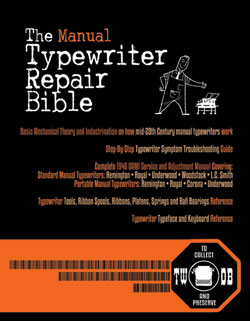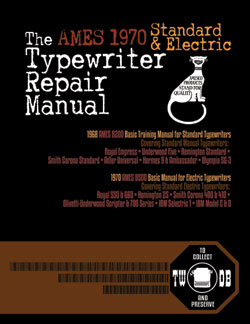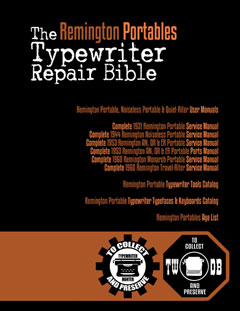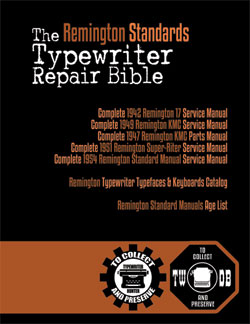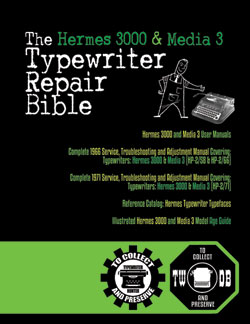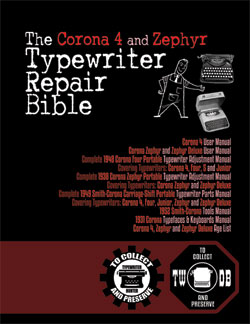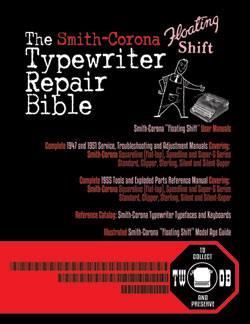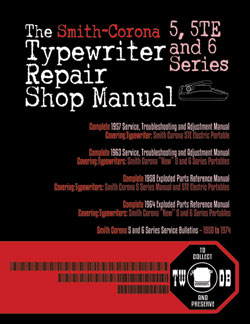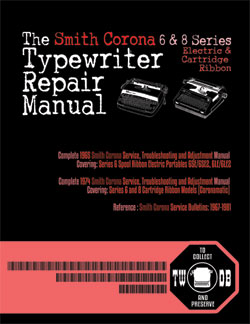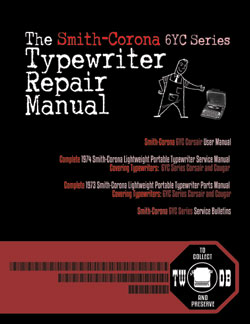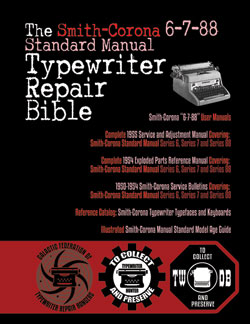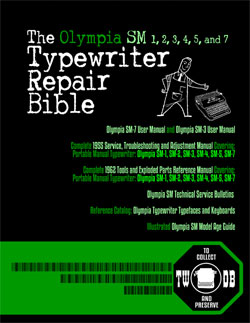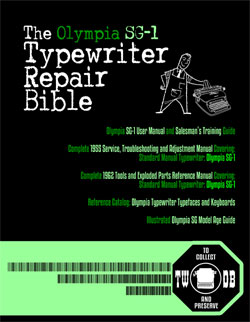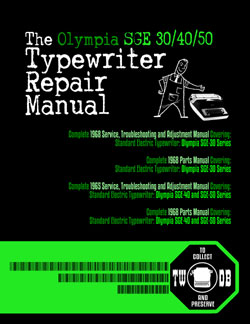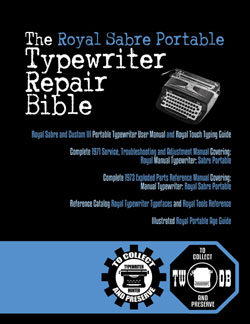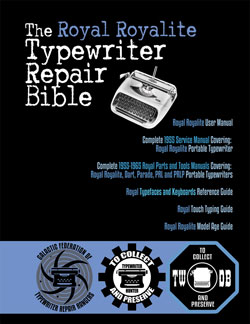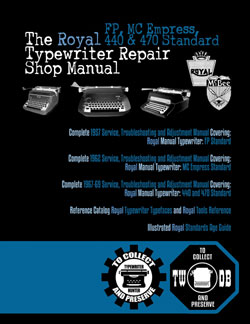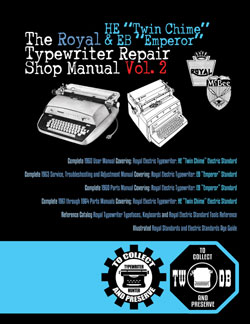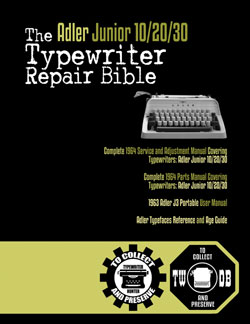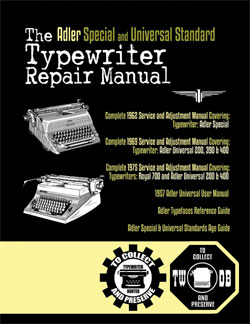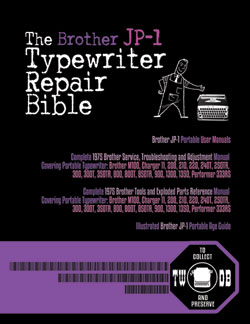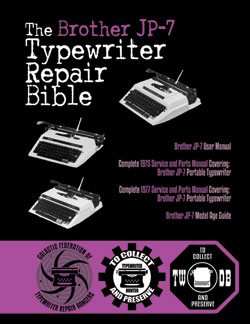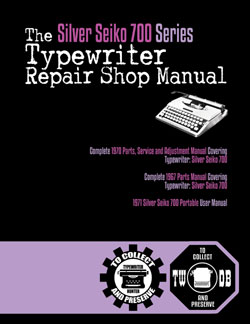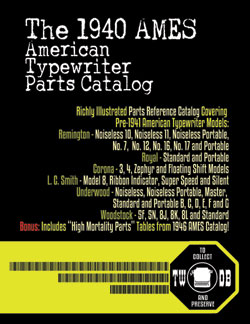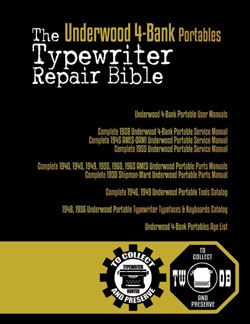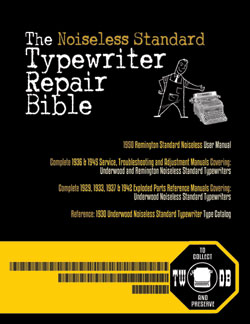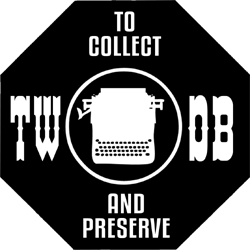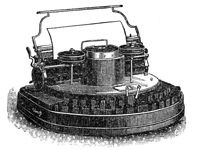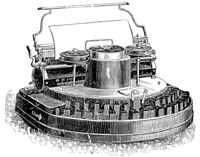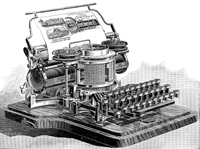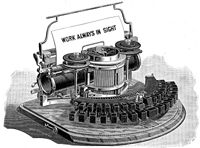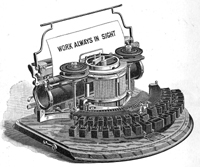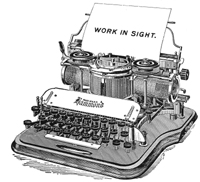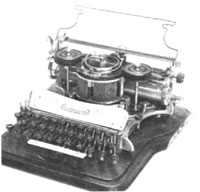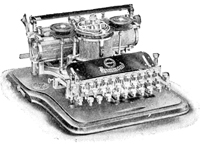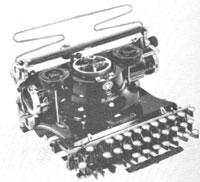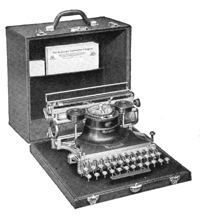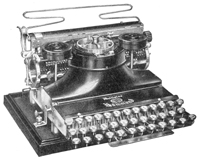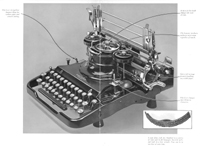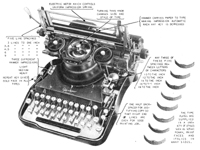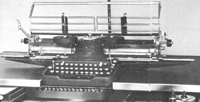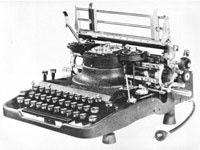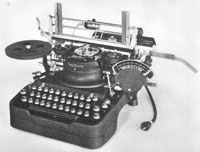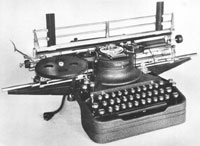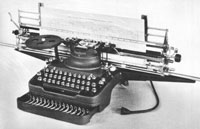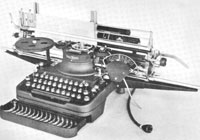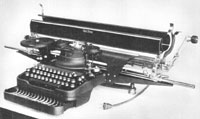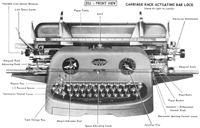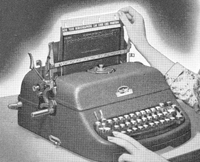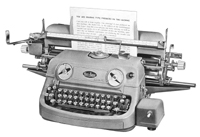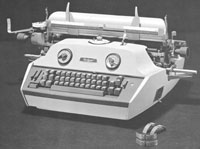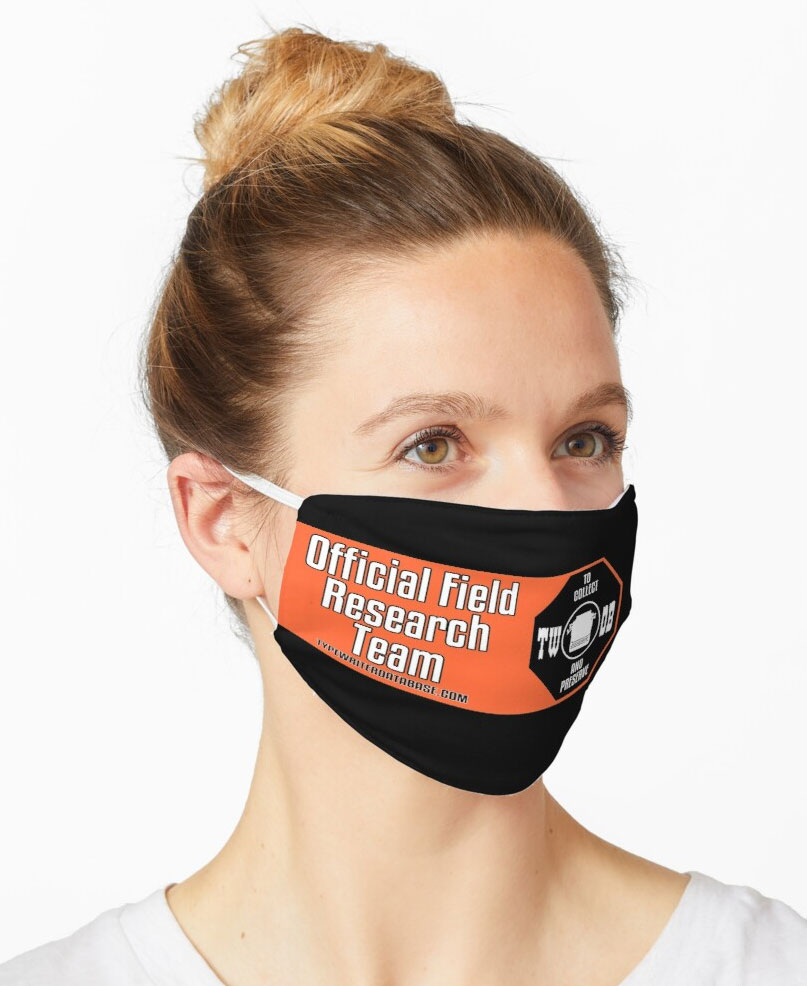Reference numbers
*
Indicates source data the current list maintainer has access to. Usually it means we have a copy of the document in question, but it might be in the form of a later edition list. However, for the purposes of validation we have been able to confirm the source.
|
| |
|
| No. |
Literature |
| 1 |
* Century of the Typewriter, Wilfred A. Beeching, publ. by
the British Typewriter Museum, 1974, 1990, ISBN 0951679007 |
| 2 |
* Joan Sales,"Date your Underwood Typewriter" - Website :
http://www.oocities.org/heartland/cottage/5405/serial.htm,
reference to Richard Polt
(note: The source for this article was at least partially Ref. #18)
|
| 3 |
Allowance Sheet 1918, made available by Andrew B. Schrader |
| 4 |
Ernst Martin, Die Schreibmaschine und ihre Entwicklungsgeschichte(The
Typewriter and the history of it's developement), publ. by Johannes Meyer
Verlag and Basten International, 1920 to 1949 and reprints |
| 5 |
* Darryl Rehr, Antique typewriters, by Schroeder publishing,
Los Angeles, 1997, ISBN 0891457577
see: http://home.earthlink.net/~dcrehr/book/book.html |
| 6 |
* Typewriter Age Guide, publ. by Office Machines and Equipment
Federation, London, copies contributed by Mr. Bruce Beard, Australia
(note: this reference same as #28) |
| 7 |
* "Liste der Herstellungsdaten gangbarer Schreibmaschinen"
Listing of the production dates of commen typewriters), publ. by Wochenschrift
für Papier, Otto Hoffmann Verlag, 1941, Berlin, copies contributed
by Mr. Paul Roberts, Netherlands. Current copy from the collection of Ryk van Dijk, scanned by Marlies Louwes. |
| 8 |
* Richard Polt, adapted from the book of Paul Lippman, American
Typewriters: A Collector's Encyclopedia (1992) and corrected, based on
a list publ. in ETCetera #4
see: http://www.aquaporin4.com/etcetera/ETC.04.pdf |
| 9 |
"Fabriknummernverzeichnis" (Factory number Listing),
booklet which could be purchased optionally with book reference No. 4,
edition 1941, publ. by Johannes Meyer Verlag, Pappenheim 1941 |
| 10 |
"Fabrikationsdaten von Schreibmaschinen", listing
of typewriter serial numbers for dealer's, 1942 and 1935, publ. by Carl
Teege Verlag, Hamburg |
| 11 |
Ames Supply General Catalog from 1949 |
| 12 |
Information contributed by Will Davis, see : http://www.hometown.aol.com/page3.html |
| 13 |
Liste der Herstellungsdaten deutscher und auslaendischer
Schreibmaschinen, 10 Auflage, 1955, publ. by Burghagen Verlag, Hamburg
(small book, pre-owned by the Adler Werke vorm. Heinrich Kleyer, Frankfurt) |
| 14 |
* Leonhard Dingwerth, Kleines Lexikon Historischer Schreibmaschinen
(Small Lexicon of Historical Typewriters), publ. by Kunstgrafik Dingwerth,
Eichendorffstr. 77, D-33415 Verl |
| 15 |
* Office Typewriter Age List No. 26, publ. by Smith-Corona, by courtesy of Mr. Ron Fuller, Los Angeles, USA
(note: this reference same as #22) |
|
| 16 |
* American Typewriters - A Collector's Encyclopedia by Paul Lippman, 1992, Hoboken |
| 17 |
* National Office Machine Dealers Assoc. "Blue Book" (NOMDA), 1964, provided by Bill Wahl |
| 18 |
* Remington Information Binder (The Sheridan Binder), 1950's to 1970's, provided by Richard Polt.
see:
http://munk.org/typecast/2011/09/07/in-preparation-for-an-updated-typewriter-serial-number-database-royal-portables/ |
| 19 |
* Interview with P. Birchmeier, Aug. 2012, reported by Georg Sommeregger.
see:
http://groups.yahoo.com/group/theportabletypewriterforum/message/31895 |
| 20 |
* National Office Machine Dealers Assoc. "Blue Book" (NOMDA), 1980, provided by Bill Wahl.
see:
http://munk.org/typecast/2011/04/22/national-office-machine-dealer-association-1972-typewriter-age-guide/ |
| 21 |
* VOSS Schreibmaschinen, 2012, published by Georg Sommeregger.
see:
https://www.sommeregger.name/typewriters/collection/VOSS.html
https://www.sommeregger.name/typewriters/collection/voss_52.html
https://www.sommeregger.name/typewriters/collection/voss_24_typewriter.html
https://www.sommeregger.name/typewriters/collection/voss_klein_voss.html
https://www.sommeregger.name/typewriters/collection/voss_privat.html
|
| 22 |
* Smith-Corona Age List #26, 1960, provided by Bill M.
see:
http://offountainpenstypewriters.blogspot.com/2012/02/typewriter-serial-numbers.html
and:
http://offountainpenstypewriters.blogspot.com/2012/02/moretypewriter-serial-numbers.html
|
|
| 23 |
* Shipman-Ward Office Machine Dealer's Line Book, Jan 1, 1954, provided by Bill Wahl.
see:
http://munk.org/typecast/2013/01/05/shipman-ward-dealers-line-book-1954%E2%80%93part-2-age-lists/ |
| 24 |
* H.F.W. Schramm, Liste der Herstellungsdaten deutscher und ausländischer Schreibmaschinen, 11th edition, Hans Burghagen Verlag, Hamburg 1962 - copy provided by Georg Sommeregger.
Additional copy from the collection of Ryk van Dijk, scanned by Marlies Louwes. |
| 25 |
* P. Frensel, Die Entwicklung der ehemaligen DDR-Schreibmaschinen-Produktion (einschliesslich der bis 1945 produzierten Schreibmaschinen in diesem Gebiet sowie der Produktion ab 1990), in: Schreibmaschinen- und Bureau-Zeitung, Nr. 10/1999, Nr. 11/2000, Nr. 12/2000 (originally published in: Mannheimer Hefte für Schriftvergleich, Nr. 1-2/1999) - provided by Georg Sommeregger and later by Otto Koponen
"The development of the former GDR typewriter production (including typewriters produced on its territory until 1945 and production after 1990)" |
| 26 |
* "The Writing Machine (A history of the typewriter)" Michael H. Adler |
| 27 |
* "Antique Typewriters from Creed to QWERTY" Michael H. Adler |
| 28 |
* Typewriter Age Guide, publ. Dec 1973 by Office Machines and Equipment
Federation, London, copies contributed by Mr. Peter Brill, Australia
(note: this reference same as #6) |
| 29 |
* Typewriter Age Guide, publ. Oct 1971 by Office Machines and Equipment
Federation, London, copies: T. Munk with the assistance of Mr. Rob Bowker, UK
|
| 30 |
* Typewriter Age Guide, publ. Oct 1980 by Office Machines and Equipment
Federation, London, copies: T. Munk with the assistance of Mr. Rob Bowker, UK
|
| 31 |
* The Business Machines and Equipment Digest, publ. 1927 by Equipment-Research Corporation, copy contributed by
Mark Adams.
see:
http://type-writer.org/?p=2850
|
| 32 |
* R. Blickensderfer and P. Robert, "The Five-Pound Secretary. An Illustrated History
of the Blickensderfer Typewriter", publ. 2003 by The Virtual Typewriter Museum, excerpt contributed by Georg Sommeregger.
|
| 33 |
* Matricolario Olivetti, copy contributed by Enrico Morozzi.
|
| 34 |
* Olivetti Graphika Serial Number List, compiled by Domenico Scarzello.
See: http://www.typewriterstory.com/index.php/ol-graphica
|
| 35 |
* Liste der Herstellungsdaten deutscher und auslandischer Schreibmaschinen - 1950. By Carl Teege, Published by Hans Burghagen Verlag.
From the collection of Ryk van Dijk, scanned by Marlies Louwes.
|
| 36 |
* Liste der Herstellungsdaten deutscher und auslandischer Schreibmaschinen - 1953. Published by Hans Burghagen Verlag.
From the collection of Ryk van Dijk, scanned by Marlies Louwes.
|
| 37 |
* National Typewriter and Office Machine Dealer's Association (NOMDA) Typewriter and Adding Machine Allowance Schedule,
February 1, 1941. From the Collection of Tony Casillo, contributed by Richard Polt.
|
| 38 |
* Wyckoff, Seamans & Benedict. Remington Standard typewriter. New York : Wyckoff, Seamans & Benedict, [188-?], accessed from the Baker Library, Harvard Business School.
See: http://pds.lib.harvard.edu/pds/view/2574435
|
| 39 |
* Documented Hammond Serial Numbers, V.4 Jan. 1, 2013 through V.7 Jul 20, 2017, Compiled by Peter Weil.
|
| 40 |
* Blick Billheads With Serial Numbers, Compiled by Peter Weil.
|
| 41 |
* Olympia, USA "Allowance Sheet T-58" (approx 1977). From the Collection of Tony Casillo, contributed by Richard Polt.
|
| 42 |
* IBM Typewriters Serial Numbers 1946 to 1977, Montreal Branch - IBM Canada Ltd. Contributed to Yahoo GolfBallTypewriterShop group by Jacques Coulombe.
|
| 43 |
* Xerox Factbook 1987
See: http://simson.net/ref/Xerox/
|
| 44 |
* IBM Selectric Adjustment & Parts Manual S241-5939-2
|
| 45 |
* Brother Service Update #31, June 20, 1985
See: http://munk.org/typecast/wp-content/uploads/2014/05/brother-datecodes-1.jpg
|
| 46 |
* Brother Letter #0203 (10/1979) "How to Determine In-Warranty Typewriters"
See: http://munk.org/typecast/wp-content/uploads/2014/05/brother-warranty-3.jpg
|
| 47 |
* Brother Service Manuals and Addendums 1974-1990 "The Edsel R. Sanders Collection"
See: http://munk.org/typecast/2014/05/06/a-brotherly-bonanza/
|
| 48 |
* National Typewriter and Office Machine Dealer's Association (NOMDA) Typewriter and Adding Machine Allowance Schedule,
1977. From the Collection of Tony Casillo, contributed by Richard Polt.
|
| 49 |
* Brother Group Corporate Profile, 2014
See: http://download.brother.com/pub/com/en/corporate/pdf/2014/broa4_3334_en.pdf
|
| 50 |
* Victor Standard Typewriters, By Will Davis
See: http://web.archive.org/web/20090830084402/http:/geocities.com/wbd641/Victor.html
|
| 51 |
* Die historische Entwicklung des Bet riebes Optima Erfurt (2008), by Eberhard Lippmann. Contributed by Vilhelm Dromberg
|
| 52 |
* Corona: The Personal Writing Machine, by S. L. Johnson
See: http://www.sljohnson.net/typewriter/corona.html
|
| 53 |
* Standard Folding Typewriter by Richard Milton
See: http://www.portabletypewriters.co.uk/portable_typewriters_standard_folding.htm
|
| 54 |
* Collect Folding Coronas, by Paul Lippman
See: http://etconline.org/backissues/ETC004.pdf?page=4
|
| 55 |
* Smith-Corona Parts and Service Manuals (1947-1999) lent by Bill Wahl
|
| 56 |
* Europe - Oliver - SIM - MAS small typewriters, by Georg Sommeregger.
See: https://sommeregger.name/typewriters/collection/OLIVER_SIM_MAS.html
|
| 57 |
* The Montana line of Hermes clones, by Mark Adams.
See: http://type-writer.org/?p=3598
|
| 58 |
* The Hermes Baby page!, by Georg Sommeregger.
See: http://www.typewriters.ch/collection/hermes_baby.html
|
| 59 |
* American Digest of Business Machines, 1924. Contributed by Richard Polt.
See: http://site.xavier.edu/polt/typewriters/ADBM1924.pdf
|
| 60 |
* "MTE-INV" Mesa Typewriter Exchange Stock Inventory Records 1950 to 1987. Contributed by Bill Wahl.
|
| 61 |
* "Mechanical Typewriters - Their History, Value, and Legacy" by Thomas A. Russo.
|
| 62 |
* "The IBM Model B typewriter" by IBM.
See: https://www-03.ibm.com/ibm/history/exhibits/modelb/modelb_intro.html
|
| 63 |
* "Remington Portables" by Richard Polt.
See: http://site.xavier.edu/polt/typewriters/rem-portables.htm
|
| 64 |
* "Moskva and Janalif Research" by Alex Sandler. (plus updates)
See: https://goo.gl/I5X12b, https://goo.gl/z0tSOq, https://goo.gl/4iq9Tz
http://odtype.blogspot.com/2016/10/moskva-3-and-4-age-lists-as-of-ix2016.html,
http://odtype.blogspot.com/2017/02/moskva-5-6-and-7-age-lists.html
|
| 65 |
* "Collector's Guide to Antique Typewriters" Dan Post, Post-Era Books, 1981.
|
| 66 |
* "The Unknown Writing Machine" Don Sutherland in The Antique Trader, 1978.
|
| 67 |
* "Don't Mind My Insanity: Updated Fox Serial Numbers" by Tyler Anderson.
See: https://wordsarewinged.blogspot.com/2016/06/dont-mind-my-insanity-updated-fox.html
|
| 68 |
* "A Very Good Year for Adler Favorit 2's" by Robert Godlieb.
See: http://badonoer.blogspot.com/2016/01/a-very-good-year-for-adler-favorit-2s.html
|
| 69 |
* "FBI Forgery by Typewriter: Re-Examining the Alger Hiss Case -
How Did His 1927 Woodstock Become a 1929 Model?" by Robert Messenger.
See: http://oztypewriter.blogspot.com/2016/01/fbi-forgery-by-typewriter-re-examining.html
|
| 70 |
* "The Littlest Typewriters: Bennett's Bantamweights" by Robert Messenger.
See: http://oztypewriter.blogspot.co.uk/2012/02/littlest-typewriters-bennetts.html
|
| 71 |
* "Re: [TYPEWRITERS] Bennett Typewriter on Yahoo Typewriter Forum" by Thomas Furtig.
|
| 72 |
* "Sabb Schreibmaschine" by Georg Sommeregger.
See: http://www.typewriters.ch/blog/2016/06/sabb-schreibmaschine/
|
| 73 |
* "Discovering the Studio Musicwriter" by Theodore Munk.
See: Etcetera #109 (link when available)
|
| 74 |
* "The Story of the Typewriter 1873-1923" Herkimer County Historical Society, 1923.
|
| 75 |
* "The Early History of the Typewriter" by Chas. E Weller (1918).
|
| 76 |
* "Old Typewriters" by Duncan James (Shire, 1993).
|
| 77 |
* "Williams Typewriter Research" by Tyler Anderson, 2016.
|
| 78 |
* "The History of the Typewriter" by Geo. Charles Mares (Gilbert Pitman, London, 1909).
|
| 79 |
* "Emerson Typewriter Research" by Tyler Anderson & Peter Weil, 2016.
|
| 80 |
* "The Emerson: The Enigma of Typewriters" by Robert Messenger.
See: http://oztypewriter.blogspot.com/2013/07/the-emerson-enigma-of-typewriters.html
|
| 81 |
* "A History of the Three-Row 'WILLIAMS' Typewriters" by Richard E. Dickerson in Historische Bürowelt No. 21 April 1988, and No. 22 July 1988.
|
| 82 |
* "Typewriter Topics: Vol. 50-52 1922" by The International Office Equipment Magazine.
|
| 83 |
* "Typewriter Topics: Vol. 6-7 1907" by The International Office Equipment Magazine.
|
| 84 |
* "Typewriter Topics: Vol. 38-40 1918" by The International Office Equipment Magazine.
|
| 85 |
* "Typewriter Topics: Vol. 41 1919" by The International Office Equipment Magazine.
|
| 86 |
* "Typewriter Topics: Vol. 29-32 1915" by The International Office Equipment Magazine.
|
| 87 |
* "The Victor Standard Typewriter" by Will Davis.
See: http://davistypewriters.blogspot.com/2015/05/the-victor-standard-typewriter.html
|
| 88 |
* "On This Day in Typewriter History: Trying to Unravel the Victor Mystery" by Robert Messenger.
See: http://oztypewriter.blogspot.com/2012/11/on-this-day-in-typewriter-history_6.html
|
| 89 |
* "The Franklin Typewriters" by Richard E. Dickerson in ETCetera #1 October, 1987.
See: http://etconline.org/backissues/ETC001.pdf
|
| 90 |
* "On This Day in Typewriter History (CVI)" by Robert Messenger.
See: http://oztypewriter.blogspot.com/2011/09/on-this-day-in-typewriter-history-cvi.html
|
| 91 |
* "the Garbell Portable Typewriter" by The Garbell family.
See: http://www.garbell.com/GarbellTypewriter.html
|
| 92 |
* "Garbell Typewriter" by Greg Fudacz.
See: http://www.antikeychop.com/#!garbell-typewriter/us0eg
|
| 93 |
* "Fox Visible Typewriters - An Overview " by Will Davis.
See: http://davistypewriters.blogspot.com/2015/08/fox-visible-typewriters-overview.html
|
| 94 |
* "Fox Portable Typewriters and the Demise of Fox Typewriter Company " by Will Davis.
See: http://davistypewriters.blogspot.com/2015/08/fox-portable-typewriters-and-demise-of.html
|
| 95 |
* "The American Stationer" 1906.
|
| 96 |
* "The American Stationer" 1907.
|
| 97 |
* "Franklin Typewriter Ephemera" collected by Peter Weil, 2016.
|
| 98 |
* "A Bennington Letter" collected by Martin Howard.
See: http://etconline.org/backissues/ETC082.pdf
|
| 99 |
* "Filing & Office Management Magazine" Volume 6, 1921.
|
| 100 |
* "Filing & Office Management Magazine" Volume 7-8, 1922.
|
| 101 |
* "Typewriter Topics: Vol. 35-37 1917" by The International Office Equipment Magazine.
|
| 102 |
* "Typewriter Topics: Vol. 44-46 1920" by The International Office Equipment Magazine.
|
| 103 |
* "On This Day in Typewriter History: Unearthing the Molle" by Robert Messenger.
See: http://oztypewriter.blogspot.com/2013/01/on-this-day-in-typewriter-history_9569.html
|
| 104 |
* "It's pronounced 'Mollie'" by Mark Adams.
See: http://type-writer.org/?p=4230
|
| 105 |
* "The Iron Age, Volume 79 - 1907".
|
| 106 |
* "Office Appliances Volume 36 - July 1922".
|
| 107 |
* "Office Appliances Volume 34 - July 1921".
|
| 108 |
* "The American Pocket Typewriter and Wellington Parker Kidder's Rochester" by Robert Messenger.
See: http://oztypewriter.blogspot.com/2014/07/the-american-pocket-typewriter-and.html
|
| 109 |
* "Crouching Tiger, Hidden Details - The early days of the Noiseless Typewriter" by Ed Neuert.
See: http://etconline.org/backissues/ETC081.pdf
|
| 110 |
* "The Merritt" by Will Davis.
See: http://davistypewriters.blogspot.com/2016/09/merritt.html
|
| 111 |
* "Yatran The Heaviest" by Alex Sandler.
See: http://odtype.blogspot.com/2016/09/yatran-heaviest.html
|
| 112 |
* "Moskva 3 and 4 age lists as of 10-2016" by Alex Sandler.
See: http://odtype.blogspot.com/2016/10/moskva-3-and-4-age-lists-as-of-ix2016.html
|
| 113 |
* "Portable Typewriters Today - February 2015" by Will Davis.
See: http://davistypewriters.blogspot.com/2015/02/portable-typewriters-today-february-2015.html
|
| 114 |
* "The Early Bar-Lock" and "Bar-Lock Typewriters - Models 4 to 15" by Bert Kerschbaumer.
See: ETCetera #98 & #114
|
| 115 |
* "AMES Supply General Catalog #10 - March, 1960".
|
| 116 |
* "AMES Supply Parts Catalog #11P - Feb., 1965".
|
| 117 |
* "The Amazing Masspro Portable Typewriter: 'Grandson' of the Standard Folding" by Robert Messenger.
See: http://oztypewriter.blogspot.com/2013/10/the-amazing-maspro-portable-typewriter.html
|
| 118 |
* "Masspro Typewriter Page" by Greg Fudacz.
See: http://www.antikeychop.com/masspro-typewriter
|
| 119 |
* "Carl P. Dietz Collection of Typewriters", by George Herrl, 1965.
|
| 120 |
* "Royal Paint Touch-Up Color List", Rev. June, 1968.
|
| 121 |
* "Olympia SM series (part 1, 1948-1964)" by Nick T.
See: http://xoverit.blogspot.com/2015/02/olympia-sm-series-part-1-1948-1964.html
|
| 122 |
* "Olympia SM series (part 2, 1964-1980s)" by Nick T.
See: http://xoverit.blogspot.com/2015/04/olympia-sm-series-part-2-1964-1980s.html
|
| 123 |
* "AMES Supply General Catalog #5 - August, 1940".
|
| 124 |
* "1975 Smith-Corona Model Prefix Guide", Discovered by Jonathan Kinser from Smith-Corona research.
|
| 125 |
* "Evolution of the Typewriter", C. V. Oden, 1917.
|
| 126 |
* "1912-1923 The Origins and Evolution of the Typewriter" Various Authors.
|
| 127 |
* "The Swedish Densmore Typewriter" by Robert Messenger.
See: http://oztypewriter.blogspot.com/2015/03/the-swedish-densmore-typewriter.html
|
| 128 |
* "All or Nakajima" by Steve K.
See: https://etzone.org/2017/06/17/all-or-nakajima
|
| 129 |
* Smith-Corona Series Estimates researched by Nick Bodemer, 2017
|
| 130 |
* Research by Peter Weil, and ephemera from The Cornelia and Peter Weil Typewriter Archives
|
| 131 |
* 1963 Hermes Baby Adjustment Manual B3, from the collection of T. Munk
|
| 132 |
* Underwood Age List, from the collection of Tony Casillo
See: http://www.typewritercollector.com/images/underwoodagelist.pdf
|
| 133 |
* 1966 & 1971 Hermes 3000 Adjustment Manuals G4,G6 & 1971, from the collection of Jacques Perrier, Museum of the Typewriter, Lausanne, Switzerland
See: https://www.perrier-sa.ch/musee/boutique/
|
| 134 |
* "Korean Typewriters" by Robert Messenger.
See: http://oztypewriter.blogspot.com/2012/01/korean-typewriters.html
|
| 135 |
* 1985 IBM Replacement Guide Form 71K6222, supplied by Clark Hinson from the collection of Roger Brockevelt
|
| 136 |
* "Blickensderferâs last hurrah as a Remington" by Mark Adams.
See: https://type-writer.org/?p=4294
|
| 137 |
* Blickensderfer Research by Peter Weil, 2017
|
| 138 |
* Etcetera #106-107
|
| 139 |
* "Briefly Blick-Bar" by Robert Messenger.
See: http://oztypewriter.blogspot.com/2016/01/briefly-blick-bar.html
|
| 140 |
"Lexikon historischer Schreibmaschinen seit 1940" (Typewriter Lexikon since 1940) published 2008 by Leonhard Dingwerth.
|
| 141 |
* "Olivetti macchine per scrivere meccaniche" published 2013 by Carlo Torchio.
From the collection of Carl Hartmann via Mario Bellini
|
| 142 |
* "The ABC in Detail" by Will Davis and Thomas FĂźrtig.
See: http://davistypewriters.blogspot.com/search?q=abc+in+detail
|
| 143 |
* "The Real Story of the Brosette Typewriter and its successor the Jaykay Portable" by Michael A. Brown.
See: http://typexnews.com/links/Brosette.pdf
|
| 144 |
* "A Royal Safari at Eighteen Years on the Net" by Will Davis.
See: https://davistypewriters.blogspot.com/2018/03/a-royal-safari-at-eighteen-years-on-net.html
|
| 145 |
"The typewriter industry, The impact of a significant technological innovation" 1970 doctoral dissertation by George Nichols Engler, UCLA.
See: https://archive.org/details/TheTypewriterIndustry
|
| 146 |
* Research by Ian Brumfield |
|
| 147 |
* Typewriter pages from Sears Catalogs: 1900-1985
From the collections of Alan Seaver (mostly), Nick Bodemer and T. Munk. |
|
| 148 |
* "Ten Most Wanted Typewriters" by Richard Polt.
See: https://site.xavier.edu/polt/typewriters/tw-10mw.html
|
| 149 |
* Messa Research by Carl Hartmann. |
|
| 150 |
* "The Dawn of the Lettera 22" by John Cooper.
See: https://atypeofmadness.com/2019/02/12/the-dawn-of-the-lettera-22
|
| 151 |
* "Litton Drags its Caravan Through the Typewriter Desert" by Robert Messenger.
See: https://oztypewriter.blogspot.com/2019/03/litton-drags-its-caravan-through.html
|
| 152 |
* "Typewriter review: 2019 Royal Classic" by Richard Polt.
See: https://writingball.blogspot.com/2019/03/typewriter-review-2019-royal-classic.html
|
| 153 |
* "GENERATION 3000" by Will Davis.
See: http://www.willdavis.org/Generation3000.html
|
| 154 |
* "Everything New in Portable Typewriters is Old Again" by Robert Messenger.
See: https://oztypewriter.blogspot.com/2013/12/everything-new-in-portable-typewriters.html
|
| 155 |
* "Pretentious Self-Indulgence, and Also Some Pretty Big Breakthroughs" by Ian Brumfield.
See: http://dailyclipper.retroid.xyz/2019/07/16/pretentious-self-indulgence-and-also-some-pretty-big-breakthroughs
|
| 156 |
"1965-1969 Royal Line Catalog" from the collection of Ian Brumfield. |
| 157 |
* "Harris Visible, Rex Visible, Demountable; Name variants; Vim Visible" by Will Davis.
See: https://davistypewriters.blogspot.com/2015/01/harris-visible-rex-visible-demountable.html
|
| 158 |
* "1973 NOMDA Blue Book" by National Office Machine Dealers Association.
|
| 159 |
* "Olympia Engineering Bulletin General-3" by ITC, Jan 1, 1969.
|
| 160 |
* "IDENTIFYING AND DATING ANTIQUE CALIGRAPH WRITING MACHINES Nos. 1-4" by Al Sumrall.
See: https://oldhoodooblog.wordpress.com/2020/03/20/identifying-and-dating-antique-caligraph-writing-machines-typewriters-nos-1-4/
|
| 161 |
* "Some Type Writers - Their Origin and Uses" By J. B. Huling in Scientific American #575 - January 8, 1887.
|
| 162 |
* "Typewriter, A Celebration of the Ultimate Writing Machine" by Paul Robert and Peter Weil, 2016.
|
| 163 |
* "The Caligraph Publications" by Paul Robert.
|
| 164 |
* "Magic, Maligners and Malfunctions. Part IV â the Waverley, Maskelyne, Rapid, Salter and Many More." by Robert Messenger.
See: https://oztypewriter.blogspot.com/2020/07/magic-maligners-and-malfunctions-part.html
|
| 165 |
* "Burroughs Adding Machine Company - Typewriters"
See: http://www.burroughsinfo.com/typewriters.html
|
| 166 |
* "Hall Typewriter Serial Numbers" by Al Sumrall
|
| 167 |
* LC Smith and Corona Service Bulletins (1939-1954) From the collection of T. Munk
|
| 168 |
* "Research on Halberg" by Theo Verkerk
See: https://www.facebook.com/groups/TypewriterCollectors/permalink/10157289533199678/
https://www.facebook.com/groups/TypewriterCollectors/permalink/10157248994634678/
https://www.facebook.com/groups/TypewriterCollectors/permalink/10157259808104678/
|
| 169 |
* Royal Royalite Parts Manuals 1955-1965 From the collection of T. Munk
|
| 170 |
* "FRISTER & ROSSMANN TYPEWRITERS"
See: https://www.fiddlebase.com/frister-rossmann/f-r-typewriters/
|
| 171 |
* Dial-a-Ribbon & Typing by Numbers
See: https://etzone.org/2022/05/05/dial-a-ribbon-typing-by-numbers
|
| 172 |
* etzone - a summary of Sharp's electronic daisy wheel models
See: https://etzone.org/sharp-2/
|
| 173 |
* etzone - a summary of Canon's electronic daisy wheel models
See: https://etzone.org/canon/
|
| 174 |
* etzone - a summary of Nakajima All's electronic daisy wheel models
See: https://etzone.org/nakajima-all/
|
| 175 |
* "Nakajima Model 800 Typewriter: The most surprising machine of ALL" by Robert Messenger
See: https://oztypewriter.blogspot.com/2012/07/nakajima-model-800-typewriter-most.html
|
| 176 |
* Ătablissements Japy Frères, Historique et technologie des machines Ă ĂŠcrire, [1946]
From the collection of Georg Sommeregger
|
| 177 |
*Leeftijdslijst van Schrijfmachines [1958]
From the collection of Robert Godlieb
|
| 178 |
*Varityper Catalog [1940]
See: https://archive.org/details/vari-typer-catalog-august-1940-300-dpi
|
| 179 |
*1952 Hermes 2000 Service info
From the collection of Trevor Brumfield
|
| 180 |
*1958 Hermes 8&9 inst. for adj. and tech notes
From the collection of Trevor Brumfield
|
| 181 |
*1959 Hermes ambassador instruct for adj.
From the collection of Trevor Brumfield
|
| 182 |
*1960-64 Hermes H-2 baby_rocket Inst. for adj. tech notes
From the collection of Trevor Brumfield
|
| 183 |
*1971 Hermes HT-9&8 Parts cat. instructr. for adj. tech notes
From the collection of Trevor Brumfield
|
| 184 |
*1976 Hermes 705 service manual
From the collection of Trevor Brumfield
|
| 185 |
*1976 Hermes 808 receiving inst. operate inst. with Tech notes
From the collection of Trevor Brumfield
|
| 186 |
*1978 Hermes HP-5 Mech. Fun. Inst. for Adj. Controls, tech notes
From the collection of Trevor Brumfield
|
| 187 |
* Akai Samurai Confirms existence of Moskva Model 1 Portable Typewriter
See: https://typecast.munk.org/2025/05/09/akai-samurai-confirms-existence-of-moskva-model-1-portable-typewriter/
|
